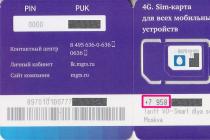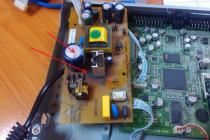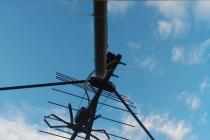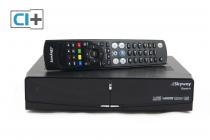For those who are just starting to take their first steps in electronics, it is important to start somewhere. Well, we suggest that you familiarize yourself with ideas that may come in handy in the future and at the same time give an idea of how something should be done. What to choose if you want to make simple ones with your own hands? Here are options that can be used in everyday life.
Simple power regulator for smooth switching on of lamps
This type of device is widely used. The simplest is a conventional diode, which is connected in series with the load. Such regulation can be used to prolong the life of the incandescent lamp, as well as to prevent overheating of the soldering iron. They can also be used to vary the power over a wide range of values. The easiest ones will come first electronic homemade products do it yourself. You can see the diagrams here.
How to protect against line voltage fluctuations

This device disconnects the load if the mains voltage is out of range. As a rule, within the normal range, a deviation of up to 10% of the standard is considered. But due to the peculiarities of the energy supply system in our country, such a framework is not always respected. So, the voltage can be 1.5 times higher, or much lower than necessary. The result is often unpleasant - the equipment fails. Therefore, there is a need for a device that will disconnect the load before something has time to burn out. But when creating such a homemade product, you need to be careful, since the work will be carried out with considerable stress.
How to make a safety transformer
In various electronic designs, transformerless power supplies are often used. Usually, such devices have low power, and to avoid electric shock, they are placed in an insulating plastic case. But sometimes they need to be configured, and then the protection is opened. To avoid possible injury, a safety isolation transformer is used. It will also be useful when repairing such devices. Structurally, they consist of two identical windings, each of which is designed for the network. As a rule, the power of transformers of this type fluctuates in the range of 60-100 W, this is optimal parameters for customizing various electronics.
A simple source of emergency lighting

What to do if it is necessary so that in the event of a power outage, the illumination of a certain area remains? An emergency luminaire based on a standard energy-saving lamp, the power of which does not exceed 11 watts, can serve as a response to such calls. So if you need the light somewhere in the corridor, utility room or workplace, this homemade product will have to be in place. Usually, when voltage is present, they work directly from the mains. When it disappears, the lamp begins to operate on battery energy. When the mains voltage is restored, the lamp will work and the battery will be automatically charged. The best do-it-yourself electronic homemade products were left at the end of the article.
Soldering Iron Boost Power Regulator

In cases where it is necessary to solder massive parts or the mains voltage often drops, the use of a soldering iron becomes problematic. And a step-up power regulator can help out from this situation. In these cases, the load (i.e. the soldering iron) is supplied with a rectified mains voltage. The change is carried out using an electrolytic capacitor, the capacity of which makes it possible to obtain a voltage greater than 1.41 network. So, with a standard voltage value of 220 V, it will give 310 V. And if a drop occurs, say, to 160 V, then it turns out that 160 * 1.41 = 225.6 V, which will allow you to operate optimally. But this is just an example. You have the opportunity to make a scheme that suits your specific conditions.
The simplest twilight switch (photo relay)

As new parts are created, fewer and fewer components are now needed to make a piece of equipment. So, for an ordinary twilight switch, only 3 of them are needed. Moreover, due to the versatility of the design, multipurpose use is also possible: in an apartment building; to illuminate the porch or courtyard of a private home, or even a separate room. Pointing to the features of such a design as a twilight switch, it is also called a "photo relay". You can find many implementation schemes that were made either by hobbyists or industrialists. They have their own set of positive and negative properties. Negative properties are usually called either the need for a constant voltage source, or the complexity of the circuit itself. Also, when buying cheap and simple parts or whole sets, they often complain that they simply burn. The functionality of the circuit is based on three components:
- Photocell. Usually, it is understood as photoresistors, phototransistors and photodiodes.
- Comparator.
- Triac, or relay.
When there is daylight, the resistance of the photocell is low and does not exceed the response threshold. But as soon as it gets dark, the structure will be turned on at the same moment.
Conclusion
Here are some interesting do-it-yourself electronic homemade products. The main thing in cases when something does not work out is to keep trying, and then everything will succeed. And having gained experience, it will be possible to move on to more complex schemes.
Every day it becomes more and more, there are many new articles, it is quite difficult for new visitors to immediately navigate and revise at a time everything that has already been written and previously posted.
I would very much like to draw the attention of all visitors to individual articles that were posted on the site earlier. In order not to have to search for a long time necessary information I will make several "entry pages" with links to the most interesting and useful articles on specific topics.
Let's call the first such page "Useful electronic homemade products". Simple electronic circuits that are available for implementation by people of all skill levels are considered here. The circuits are built using a modern electronic base.
All information in the articles is presented in a very accessible form and to the extent necessary for practical work... Naturally, to implement such schemes, you need to understand at least the basics of electronics.
So, a selection of the most interesting articles on the site "Useful electronic homemade products"... The author of the articles is Boris Aladyshkin.
The modern element base of electronics greatly simplifies the circuitry. Even an ordinary twilight switch can now be assembled from just three parts.
The article describes a simple and reliable electric pump control scheme. Despite the extreme simplicity of the circuit, the device can operate in two modes: water rise and drainage.
The article contains several schemes of devices for spot welding.
With the help of the described structure, it is possible to determine whether or not a mechanism located in another room or building is working. The vibration of the mechanism itself is information about the work.
A story about what a safety transformer is, what it is for and how you can make it yourself.
Description of a simple device that disconnects the load if the mains voltage goes out of range.
The article describes a circuit of a simple thermostat using an adjustable zener diode TL431.
An article on how to make a device for smoothly switching on lamps using the KR1182PM1 microcircuit.
Sometimes, with reduced voltage in the network or soldering of massive parts, it becomes simply impossible to use a soldering iron. This is where a step-up power regulator for a soldering iron can come to the rescue.
An article about what can be replaced mechanical thermostat oil heating radiator.
Description of a simple and reliable thermostat circuit for a heating system.
The article gives a description of the converter circuit, made on a modern element base, containing a minimum number of parts and allowing to obtain significant power in the load.
An article about various ways to connect a load to a control unit on microcircuits using relays and thyristors.
Description of a simple control circuit for LED garlands.
The design of a simple timer that allows you to turn on and off the load at specified time intervals. The working time and the pause time do not depend on each other.
Description of the circuit and principle of operation of a simple emergency luminaire based on an energy-saving lamp.
A detailed story about the popular "laser-ironing" technology for manufacturing printed circuit boards, its features and nuances.
Electronic homemade products, for today, are in an accessible way making useful mechanisms that can make life easier and diversify leisure. Modern craftsmen are able to assemble both simple toys and complex, multitasking mechanisms with their own hands. How to easily and quickly make electronic toys, interesting and useful electronic homemade products for your home and car with your own hands - read below!
Simple DIY electronics: making a spinner
Electrical engineering is widely used today for both practical and recreational purposes. Some inventions (such as, for example, a “smart home” system) will be quite difficult for a beginner to make. They require experience and in-depth knowledge of physics. Other designs are simple and affordable for novice radio amateurs. So, for example, you can make interesting toys with your own hands - spinners, the sales of which have increased incredibly this year.
To assemble a toy, you will need to stock up on:
- Wooden blank 9x4x1.2 cm;
- Bearing 2.2X0.8x0.7 cm (with rubber seal);
- Two RGB LEDs;
- Two batteries and CR2032 holders;
- Stainless steel bolt 0.8x2 cm;
- Cap nuts M8.
After that, you can start working. First of all, you will need to find a design diagram on the Internet, and transfer it to an untreated block - a blank. To correctly mark the technological holes (there will be three of them), you will need a ruler.

Then follows:
- Drill a 2.2 cm through hole in the middle of the workpiece for the bearing;
- Drill two holes with a diameter of 2.5 cm and a depth of 7.5 mm on the sides of the workpiece;
- Using a drill, make two blind holes in the middle of two blind holes with a diameter of 6 mm for LEDs;
- Process the holes with a countersink;
- Give the toy a rounded shape using a jigsaw, band saw or jigsaw;
- Sand the workpiece with sandpaper and varnish it;
- Solder the LEDs to the battery holders;
- Check the LEDs, and install them in the mounting holes, fixing them with super glue;
- Clean the bearing, and treat its insides with WD 40;
- Cut off the bolt head, and fix the axle in the bearing on both sides with nuts;
- Install the bearing into the bore.
The spinner is ready! The toy will be interesting not only for children. Adults can also use such an electronic device: the device, while rotating, will help to relax or be distracted.
Simple schemes of electronic homemade products: making an electric call
You can make an electric call quite simply and quickly with your own hands.
Such a call will last a long time and will delight the ear. Indeed, when pressed, it will be able to create signals of different frequencies and tones.
So, an electric call can be single-tone and multi-tone.
The ability of a call to reproduce sound in one or more tonalities will be affected by the presence in the radio design of a multivibrator with two bipolar transistors. Let us consider in detail the scheme of an electronic call with a complex sound signal.
So, electronic homemade scheme will consist of the following radio components:
- Step-down transformer of the TA series;
- Bell button;
- Five fused silicon diodes;
- 1000 microfarad electrolytic capacitor
- Two electrolytic capacitors with a capacity of 10 microfarads;
- Two trimming resistors with a resistance of 470 kilo-ohms;
- Two MLT resistors with a resistance of 10 kilo-ohms;
- Two MLT resistors with a resistance of 33 kilo-ohms;
- 1 kilo-ohm MLT resistor;
- 470 kilo-ohm MLT resistor;
- Three silicon-plenary transistors of the 630D type
- Silicon planar transistor type 630G.
The principle of operation of the device is simple. Pressing the button will open the third 630D transistor, allowing current to flow to the fourth 630G transistor. This will create the primary signal. When the second transistor of the 630D type is opened, the third and fourth transistors will be locked, creating a signal of a different tonality.
DIY homemade products for a car
Car electronics, today, is in great demand. At the same time, home-made automation often has simple schemes, easy execution and installation. What kind of electric self-made products can you make yourself for your car?
So, with your own hands for a car you can do:
- Dynamic turn signals using the KIT DIY constructor;
- Universal Charger from old electronics;
- Air conditioner based on a water pump;
- Heated wipers and more.
The easiest way would be to design the lights for the seat belt buckles. To do this, it will be necessary to dismantle and disassemble the locks using a flat screwdriver. After that, with the help of hot glue in the locks, it is necessary to fix the LEDs.
Each LED can be switched on through its own current limiting resistor: this will extend the life of the semiconductor light emitting device.
After that, the locks should be assembled, and the wires supplying the LEDs should be pulled under the seats to the ignition or the size button through the cigarette lighter. At the request of the owner, the car interior lighting can be supplemented with lamps that signal that the seat belt is not fastened.
Unusual electronic homemade products: do-it-yourself binary clock
You can make a cool binary clock for your home with your own hands. To do this, you need the Arduino platform. Wiring diagrams on this platform are simple and convenient, they are used for the manufacture of most electronic homemade products.

In addition, to make a binary clock, you will need:
- Real time clock module on the DS1302 microcircuit;
- Diffuse LEDs with a diameter of 1 cm (20 pieces);
- Resistors with a resistance of 10 ohms (20 pieces);
- Resistors with a resistance of 10 kilo-ohms (2 pieces);
- Two tact buttons;
- Frame.
The watch case should consist of two halves, which can be made of wood, plastic, metal. It depends on what style your watch is going to be. Before making the case, you will need to assemble the LED matrix.
In this case, each LED must be connected through its own current-limiting resistor.
After that, the leads from the LEDs must be connected to the platform. The controller itself will need to be connected to the real time clock module. After that, contacts from Arduino and the module must be carried out to timekeepers for setting the time through resistors with a nominal value of 10 kilo-ohms. They will serve as load. Finally, connect the power cable to the circuit.
Useful DIY homemade products: how household scales are made
Today, almost every home has a floor or kitchen scale. In order to independently make this useful measuring device, you need to understand its structure and principle of operation.
So, the external components of the scales include:
- Weight processor;
- Frame;
- Screen for readings;
- Platform;
- Legs.
The principle of the balance is extremely simple. The load, falling on the platform, presses on it due to the force of gravity, activating the strain gauge weight sensor inside the device. The strain gauge, in turn, affects the strain gage, changing its resistance. The latter transmits the signal to the analog-to-digital converter. After that, the ADC converts the signal into digital and feeds it to the microcontroller, which draws conclusions about the weight of the load on the platform, and displays the values on the screen.
When assembling the circuit, you must pay attention to the type of strain gauge.
So, for a central location under the platform of floor, commercial and technical scales, it is better to choose a single-point sensor. A block sensor is used for bending installation. In this case, you need to ensure that the strain gauge has a reliable connection to the ADC. The weight processor will help to solve the problem of connecting devices.
DIY radio circuits for home: making an electronic lock
An electrician can also be used to protect a home. So, today, homemade sites offer simple radio circuits for electronic locks for the front door. Opening such a lock using a physical key will not work.
The simplest wiring diagram for making a lock is usually based on a four-digit Johnson counter.
This scheme can be implemented in several variations. The simplest is using the 4017 microcircuit. The principle of operation of the circuit is quite simple: when you enter correct code, consisting of four digits, a logical unit is activated at the input of the microcircuit, which opens the lock.
Let's consider the operation of the device in more detail:
- When the wrong keys are pressed, the circuit is restarted without triggering the mechanism through the RESET input.
- The correct signal, when the key is pressed, must go to the field-effect transistor VT1, which, after opening, supplies voltage to the output corresponding to the key;
- After the full introduction of the correct code, from the output corresponding to the last correct key, the signal is fed to the VT2 transistor connected to the relay;
- The transistor is activated for a time that determines the capacitance of the capacitor;
- The relay opens an actuator (eg a latch).
In order to open such a lock, you will need to sort out about ten thousand different codes. In this case, the numbers on the code should not be repeated. That is, the code 3355 will not be possible, all digital values must be different.
Most electronic homemade products that are made by modern craftsmen are designed to perform ordinary household tasks faster and better than authentic devices. So, for example, the electric spinning wheel will significantly speed up the process of creating yarn. You can quickly make an electric spinning wheel by placing an electric motor on an authentic device.
At the same time, the motor for the electric spinning wheel must have a power of at least 15 watts.
As a motor, it will be possible to use a motor from a fan, an auto wiper, a turntable. Use the foot pedal to drive the engine. It will be possible to change the movement of the motor by including a TP type toggle switch in the circuit, which provides the connection of a capacitor and resistance to different windings.
An electric swatter will be useful, easy to assemble and operate.
In order to implement such a mechanism, it will be necessary to assemble a standard blocking generator. In this case, you will need to remember to insulate the fly swatter handle.
Where to find amateur radio circuits and homemade products
Modern sites of radio amateurs offer to make not only useful, but also unusual radio self-made. So, for example, on the Mozgochina website, you can find interesting electronic circuits for making reminders for the refrigerator, thermometers that change color depending on the temperature, etc.
Electric things for everyday life and crafts from scrap materials for fishing from the site “Visiting Samodelkin” will be interesting and useful.
You can read about how to design, debug and manufacture electronic mechanisms at home in the book "Entertaining radio electronics". Novelties among radio self-modelers are often published by the site “Workshop of the radio amateur”. New issues of the Radio Amateurs magazine contain interesting and useful technical materials.
DIY homemade products at home (video)
Radio amateur circles are, today, popular with both schoolchildren and adults. Master classes and radio circuits presented on various sites allow you to assemble almost any electrical appliances at home. The main thing is to find the necessary circuits, strictly follow the instructions, and adhere to safety precautions when working with electricity. And you can collect whatever you want!
One of the common hobbies of hobbyists and electronics professionals is the design and manufacture of various homemade products for the home. Electronic homemade products do not require large material and financial costs and can be performed at home, since work with electronics is, for the most part, "clean". The only exception is the manufacture of various body parts and other mechanical assemblies.
Useful electronic homemade products can be used in all areas of everyday life, from the kitchen to the garage, where many are engaged in the improvement and repair of electronic devices in a car.
Homemade products in the kitchen
Electronic homemade kitchens can be added to existing accessories and supplies. Industrial and home-made electric BBQ grills are very popular among apartment residents.

Another common example of homemade kitchens made by a home electrician is timers and automatic lighting over work surfaces, electric ignition of gas burners.
Important! Changing the design of some household appliances, especially gas appliances, can cause "misunderstanding and rejection" of regulatory organizations. Moreover, it requires great care and attention.
Electronics in the car
Homemade devices for a car are most widespread among the owners of domestic brands of transport, which differ in the minimum number additional functions. The following schemes are in wide demand:
- Sound signaling devices for turns and handbrake engagement;
- Operating mode indicator battery and a generator.

More experienced radio amateurs are engaged in equipping their car with parking sensors, electronic window regulators, automatic light sensors to control low beam headlights.
Homemade products for beginners
Most novice radio amateurs are engaged in the manufacture of structures that do not require high qualifications. Simple proven designs can serve for a long time and not only for the sake of benefit, but also as a reminder of the technical "maturation" from a novice radio amateur to a professional.
For inexperienced amateurs, many manufacturers produce ready-made construction kits that contain printed circuit board and a set of elements. Such kits allow you to practice the following skills:
- Reading circuit and wiring diagrams;
- Correct soldering;
- Adjustment and adjustment according to the ready-made method.
Among the sets are very common Digital Watch various versions and degrees of complexity.

As an area of application of knowledge and experience, radio amateurs can design electronic toys using simpler circuits or reworking industrial structures to their wishes and capabilities.
Interesting ideas for crafts can be seen in the examples of making radio electronic crafts from worn-out parts of computer technology.
Home workshop
For the independent design of radio electronic devices, a certain minimum of tools, devices and measuring instruments :
- Soldering iron;
- Side cutters;
- Tweezers;
- Screwdriwer set;
- Pliers;
- Multifunctional tester (avometer).
On a note. When planning to do electronics with your own hands, you should not tackle complex structures right away and purchase an expensive tool.
Most radio amateurs began their journey with the use of the simplest soldering iron 220V 25-40W, and from the measuring instruments in the home laboratory, the most massive Soviet tester Ts-20 was used. All this is enough for practicing with electricity, acquiring the necessary skills and experience.

It makes no sense for a novice radio amateur to buy an expensive soldering station if there is no necessary experience with a conventional soldering iron. Moreover, the possibility of using the station will not appear soon, but only after sometimes quite a long time.
Also, there is no need for professional measuring equipment. The only serious device that even a novice hobbyist may need is an oscilloscope. For those already versed in electronics, the oscilloscope is one of the most sought after measurement tools.

Inexpensive Chinese-made digital devices can be successfully used as an avometer. Having rich functionality, they have high measurement accuracy, ease of use and, what is important, have a built-in module for measuring transistor parameters.
Speaking of a homemade workshop at a homemade product, one cannot fail to mention the materials used for soldering. This is solder and flux. The most common solder is POS-60 alloy, which has a low melting point and ensures high soldering reliability. Most of the solders used for soldering all kinds of devices are analogs of the mentioned alloy and can be successfully replaced by it.
As a flux for soldering, ordinary rosin is used, but for ease of use it is better to use its solution in ethyl alcohol. Rosin-based fluxes do not need to be removed from the installation after work, since they are chemically neutral under most operating conditions, and a thin rosin film formed after the evaporation of the solvent (alcohol) exhibits good protective properties.
Important! When soldering electronic components under no circumstances should active fluxes be used. This is especially true of soldering acid (zinc chloride solution), since even under normal conditions such a flux has a destructive effect on thin copper printed conductors.
For maintenance of highly oxidized leads, it is better to use active acid-free flux LTI-120, which does not require rinsing.
It is very convenient to work using solder, which includes a flux. The solder is made in the form of a thin tube with rosin inside.

Breadboards made of double-sided foil-clad fiberglass, which are produced in a wide range, are well suited for the installation of elements.

Security measures
Electricity is associated with a risk to health and even life, especially if the electronics are designed with their own hands with a mains supply. Homemade electrical devices must not use a transformerless AC mains supply. In an extreme case, the adjustment of such devices should be done by connecting them to the network through an isolation transformer with a transformation ratio equal to one. The voltage at its output will correspond to the mains, but at the same time, reliable galvanic isolation will be provided.
So. Life has developed in such a way that I have a house in the village with gas heating. It’s impossible to live there all the time. The house is used as a summer residence. For a couple of winters, I stupidly left the boiler on with a minimum coolant temperature.
But there are two drawbacks.
1. Gas bills are astronomical.
2. If there is a need to come to the house in the middle of winter, the temperature in the house is around 12 degrees.
Therefore, it was necessary to invent something.
I'll clarify right away. The presence of a WI-FI access point in the range of the relay is required. But, I think, if you get confused, you can put a connected mobile phone next to the sensor and distribute a signal from the phone.
Connecting a motion sensor 4 pins with your own hands diagram
Diagram of connecting a motion sensor with your own hands

It happens that you need to install in the country, or in the house lighting that will be triggered when moving or a person or someone else.
This function is handled well by the motion sensor, which I ordered from Aliexpress. The link to which will be below. By connecting light through the motion sensor, when a person passes through his field of vision, the light turns on, burns for 1 minute. and turns off again.
In this article I will tell you how to connect such a sensor if it does not have 3 contacts, but 4 like this one.
DIY power supply from an energy-saving light bulb
 When to get 12 Volts for led strip
, or for some other purpose, there is an option to make such a power supply unit with your own hands.
When to get 12 Volts for led strip
, or for some other purpose, there is an option to make such a power supply unit with your own hands.
DIY fan speed controller

This regulator allows you to smoothly adjust variable resistor fan speed.
The floor fan speed regulator circuit turned out to be the simplest. To fit into the case from old charge Nokia phone... Terminals from an ordinary electrical outlet also fit in there.
The installation is quite tight, but this was due to the size of the case ..
DIY lighting for plants
DIY lighting for plants

There is a problem in the lack of lighting plants, flowers or seedlings, and there is a need for artificial light for them, and this is the kind of light we can provide on LEDs do it yourself.
Diy brightness control
Diy brightness control

It all started with the fact that after I installed halogen lamps for lighting at home. When turned on, which often burned out. Sometimes even 1 light bulb a day. Therefore, I decided to make a smooth switching on of the lighting based on the dimmer with my own hands, and I am attaching the dimmer circuit.
DIY refrigerator thermostat
DIY refrigerator thermostat

It all started with the fact that after returning from work and opening the refrigerator, he found it warm. Turning the thermostat knob did not help - the cold did not appear. Therefore, I decided not to buy a new unit, which is also rare, but to make an electronic thermostat myself on the ATtiny85. With the original thermostat, the difference is that the temperature sensor is on the shelf and not hidden in the wall. In addition, 2 LEDs have appeared - they signal that the unit is turned on or the temperature is above the upper threshold.
DIY soil moisture sensor
DIY soil moisture sensor

This device can be used for automatic watering in greenhouses, flower greenhouses, flower beds and indoor plants. Below is a diagram by which you can make the simplest sensor (detector) of moisture (or dryness) of the soil with your own hands. When the soil dries up, a voltage is supplied with a current strength of up to 90mA, which is quite enough, turn on the relay.
It is also suitable for automatically turning on drip irrigation to avoid excess moisture.
Fluorescent lamp power circuit
Fluorescent lamp power circuit.

Often upon failure energy-saving lamps, in it burns out power circuit, and not the lamp itself. As is known, LDS with burned-out filaments, it is necessary to supply with rectified mains current using a starless starter device. In this case, the filaments of the lamp are shunted with a jumper and to which a high voltage is applied to turn on the lamp. There is an instant cold ignition of the lamp, a sharp increase in voltage across it, when starting without preheating the electrodes. In this article we will look at do-it-yourself lds lamp start-up.
USB keyboard for tablet
USB keyboard for tablet

Somehow, suddenly, I took something and decided to buy a new keyboard for my PC. The desire for novelty cannot be overcome. Changed the background color from white to black, and the color of the letters from red-black to white. A week later, the desire for novelty naturally went like water into sand (an old friend is better than two new ones) and the new thing was sent to the closet for storage - until better times. And so they came for her, did not even imagine that it would happen so quickly. And therefore the name would be even better suited not which is, but how to connect a usb keyboard to a tablet.














